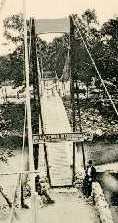Suspension Bridges of Oklahoma
This is a list of all 36 bridges from the suspension bridge inventory for Oklahoma in USA. Wherever you see a Bridgemeister ID number click it to isolate the bridge on its own page.
Related Lists:
1894: Stell
Chickasha, Oklahoma, USA - Washita River
| Bridgemeister ID: | 2332 (added 2007-07-07) |
| Year Completed: | 1894 |
| Name: | Stell |
| Location: | Chickasha, Oklahoma, USA |
| Crossing: | Washita River |
| Use: | Vehicular (one-lane) |
| Status: | Removed |
| Main Cables: | Wire |
External Links:
- Turnpikes and Toll Bridges | The Encyclopedia of Oklahoma History and Culture. Image of the bridge. It appears to have been similar to the Flinn-Moyer Beveridge Bridge in Texas.
1898: Noble
Noble, Oklahoma, USA - South Canadian River
| Bridgemeister ID: | 107 (added before 2003) |
| Year Completed: | 1898 |
| Name: | Noble |
| Location: | Noble, Oklahoma, USA |
| Crossing: | South Canadian River |
| Coordinates: | 35.139500 N 97.407333 W |
| Maps: | Acme, GeoHack, Google, OpenStreetMap |
| Principals: | Ed Garee |
| Use: | Vehicular (one-lane) |
| Status: | Destroyed, 1904 |
| Main Cables: | Wire |
| Suspended Spans: | 3 |
| Main Span: | 1 x 80.8 meters (265 feet) |
| Side Spans: | 2 |
| Deck width: | 14 feet |
Notes:
- Coordinates are approximate location of the bridge.
- Wrecked by flood October 3rd or 4th, 1904.
1909: Ripley
Ripley, Oklahoma, USA - Cimarron River
| Bridgemeister ID: | 298 (added before 2003) |
| Year Completed: | 1909 |
| Name: | Ripley |
| Location: | Ripley, Oklahoma, USA |
| Crossing: | Cimarron River |
| Principals: | Mitchell & Pigg |
| Use: | Vehicular (one-lane) |
| Status: | Wrecked, 1912 |
| Main Cables: | Wire (steel) |
| Suspended Spans: | 3 |
| Main Span: | 1 |
| Side Spans: | 2 |
Notes:
- The photo linked here is dated March 2, 1909. Part of the builders plate is legible. The first line appears to be: "Wfd Mch & Fo... Co." (the portion between the Fo and Co is obscured) for Weatherford Machine and Foundry Company. The next two lines are clear: "BUILDERS 1908" and "WEATHERFORD TEXAS". The last line is largely obscured but it appears to say "MITCHELL & PIGG PAT'D 1..." with a year at the end. Mitchell & Pigg was a well-known builder of suspension bridges in Texas. Most sources cite 1909 as the year of completion.
- South tower washed out, 1912.
- Replaced by Ripley - Ripley, Oklahoma, USA.
- All past and present bridges at this location.
Image Sets:
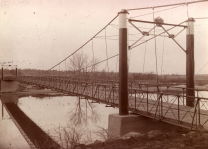
1913: Swinging
Tishomingo, Oklahoma, USA - Pennington Creek
| Bridgemeister ID: | 129 (added before 2003) |
| Year Completed: | 1913 |
| Name: | Swinging |
| Location: | Tishomingo, Oklahoma, USA |
| Crossing: | Pennington Creek |
| Coordinates: | 34.234639 N 96.682861 W |
| Maps: | Acme, GeoHack, Google, OpenStreetMap |
| Principals: | Western Bridge Company |
| Use: | Vehicular |
| Status: | Destroyed |
Notes:
- The description on the back of a postcard reads: "The only remaining swinging bridge in the state of Oklahoma crossable by automobile spans beautiful Pennington Creek in Tishomingo. The guaranteed strength of the bridge is 164 tons and is located 3 blocks south of the old Chickasaw Capitol on South Capitol Avenue. The bridge was built by Western Bridge Company of Sherman, Texas and was dedicated November 28, 1913."
- Destroyed by flood.
- An article in the April 7, 1964 issue of The Ada Evening News (Oklahoma) titled "Tishomingo Acts To Save Famed Bridge": "Tishomingo's Swinging Bridge, a landmark since Territorial days, may yet be saved from the junk man. Indeed, with a little luck, it may be put back into service to carry traffic across Pennington Creek as it did in its heyday. Some 25 persons attended a regular city council meeting Monday night to urge that the bridge be repaired; and the council appointed a committee to look into the cost of such a project. "It looks favorable," Mayor Lee butler said Tuesday. "It looks like we might get it repaired." The old suspension bridge has been closed to traffic for several years. Floor planks have rotted and fallen away, and the whole structure was condemned as unsafe. The problem of financing has held the city back from repairing the ancient structure. However, Butler said the county commissioners have offered to help, and quite a few individual citizens have promised donations to assist the project. When the committee reports back on the cost, Butler said, the council will be ready to take action."
- The bridge must have been repaired in the mid-1960's and reopened. An article in the July 9, 1978 issue of The Ada Evening News (Oklahoma) titled "Repair of Tishomingo's Suspension Bridge Slated": "Work is expected to begin in the near future on the renovation of the suspension bridge here which spans Pennington Creek. The landmark structure and last swinging bridge in the state open to vehicular traffic was closed last May when city officials deemed it was 'too dangerous' to keep open due to its deteriorated state. In an effort to reopen the bridge as soon as possible, the Tishomingo City Council acted last week to approve funding for materials necessary to repair the 65-year-old structure and has arranged for participants in the Young Adult Conservation Corps camp at Sulphur to provide the manpower needed for the work. Frank Glover, head of the Tishomingo street department, said the Johnston County commissioners have also promised to aid in the repair of the bridge. Glover said he hopes the renovation will be completed this summer. He estimated materials for the work will cost the city about $5,000- $6,000. The bridge will have to be renovated from the bottom up, including the replacement of the entire wooden floor, Glover said. He said city officials are still looking for someone knowledgeable about the construction of suspension bridges to aid in the repair of the structure."
Image Sets:
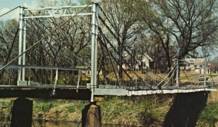
| Bridgemeister ID: | 600 (added 2003-01-11) |
| Year Completed: | 1914 |
| Name: | 98th Meridian |
| Also Known As: | Byers |
| Location: | Byers, Texas and Temple, Oklahoma, USA |
| Crossing: | Red River |
| Coordinates: | 34.124507 N 98.214251 W |
| Maps: | Acme, GeoHack, Google, OpenStreetMap |
| Principals: | Mitchell & Pigg |
| References: | AUB, HAERTX98, PTS2 |
| Use: | Vehicular |
| Status: | Destroyed, 1923 |
| Main Cables: | Wire (steel) |
| Suspended Spans: | 4 |
| Main Spans: | 3 x 172.8 meters (567 feet) |
| Side Span: | 1 x 32.6 meters (107 feet) |
Notes:
- Destroyed by tornado, 1923.
- Coordinates are the exact location of one of the remaining (as of 2020) piers of either this bridge or its replacement suspension bridge. Additional piers, south of that location, are also visible in satellite images.
- Replaced by 1923 98th Meridian (Byers) - Byers vicinity, Texas and Temple, Oklahoma, USA.
- See (suspension bridge) - Texas, USA. The 98th Meridian bridge may match this unknown "Red River" bridge photo. AUB describes the Byers bridge, "This bridge, three spans of 567' each, one side span of 107', and a 16' roadway, had originally been built in 1914."
- All past and present bridges at this location.
1917: Morrison
Morrison vicinity, Oklahoma, USA - Black Bear Creek
| Bridgemeister ID: | 2238 (added 2007-03-24) |
| Year Completed: | 1917 |
| Name: | Morrison |
| Location: | Morrison vicinity, Oklahoma, USA |
| Crossing: | Black Bear Creek |
| Coordinates: | 36.30811 N 96.95164 W |
| Maps: | Acme, GeoHack, Google, OpenStreetMap |
| Principals: | N.H. Sturgis |
| Use: | Vehicular (one-lane) |
| Status: | Removed |
| Main Cables: | Wire |
| Bridgemeister ID: | 595 (added 2003-01-11) |
| Year Completed: | 1917 |
| Name: | Terral-Ringgold |
| Location: | Ringgold, Texas and Terral, Oklahoma, USA |
| Crossing: | Red River |
| Coordinates: | 33.878143 N 97.934776 W |
| Maps: | Acme, GeoHack, Google, OpenStreetMap |
| References: | AUB, PTS2 |
| Use: | Vehicular |
| Status: | Removed |
| Main Cables: | Wire |
| Suspended Spans: | 5 |
| Main Spans: | 3 x 137.2 meters (450 feet) |
| Side Spans: | 2 |
Notes:
- 1931: Replacement opened.
1921: Bridgeport
Bridgeport and Geary, Oklahoma, USA - South Canadian River
| Bridgemeister ID: | 1660 (added 2005-03-19) |
| Year Completed: | 1921 |
| Name: | Bridgeport |
| Also Known As: | Key, Postal |
| Location: | Bridgeport and Geary, Oklahoma, USA |
| Crossing: | South Canadian River |
| Coordinates: | 35.567306 N 98.374731 W |
| Maps: | Acme, GeoHack, Google, OpenStreetMap |
| References: | PTS2 |
| Use: | Vehicular |
| Status: | Removed |
| Main Cables: | Wire (steel) |
Notes:
- Remnants of at least one pier still standing, 2019.
| Bridgemeister ID: | 5589 (added 2020-12-22) |
| Year Completed: | 1923 |
| Name: | 98th Meridian |
| Also Known As: | Byers |
| Location: | Byers vicinity, Texas and Temple, Oklahoma, USA |
| Crossing: | Red River |
| Coordinates: | 34.127249 N 98.214114 W |
| Maps: | Acme, GeoHack, Google, OpenStreetMap |
| Principals: | Austin Bridge Co. |
| References: | AUB |
| Use: | Vehicular |
| Status: | Destroyed, 1938 |
| Main Cables: | Wire (steel) |
Notes:
- AUB describes the Byers bridge: "This bridge, three spans of 567' each, one side span of 107', and a 16' roadway, had originally been built in 1914."
- 1935: Damaged by flood.
- 1938: Destroyed by flood.
- Replaced 1914 98th Meridian (Byers) - Byers, Texas and Temple, Oklahoma, USA.
- All past and present bridges at this location.
Image Sets:
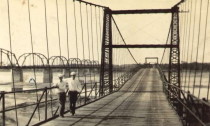
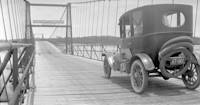
1923: McKeown
Tyrola, Ada vicinity and Konawa, Oklahoma, USA - Canadian River
| Bridgemeister ID: | 2146 (added 2006-11-11) |
| Year Completed: | 1923 |
| Name: | McKeown |
| Also Known As: | Ada-Konawa |
| Location: | Tyrola, Ada vicinity and Konawa, Oklahoma, USA |
| Crossing: | Canadian River |
| References: | PTS2 |
| Use: | Vehicular |
| Status: | Removed, 1936 |
| Main Cables: | Wire |
Notes:
- J.W. Pigg (of Mitchell & Pigg, prominent Texas suspension bridge builders of the early 20th century) was reportedly involved in the construction of the bridge. Steinman gives a date of 1922, but newspaper articles from mid-1923 describe the plans as still under consideration. The bridge was likely completed in 1923 or 1924.
- A photograph of the bridge appears in the December 16, 1934 issue of The Daily Oklahoman (Oklahoma City) with caption: "This Old Bridge Is Doomed," sub-caption "Suspension Bridge on Highway 48 North of Ada," and a blurb: "This old bridge, known as the McKeown bridge, across the Canadian River between Ada and Konawa, is being condemned and will be rebuilt. It is a suspension bridge, one of the few in the state, but when the bridge is rebuilt it will be minus its 'suspenders.'"
- The November 12, 1936 edition of The Ada Evening News reports: "The old suspension, bridge across the river north ot Ada is being torn down, but no one knew just where it will be located when and if it is rebuilt. Konawa wants to build it west of the city of Konawa. Mr. Clark [division engineer for the state highway department] did not know if any provisions have yet been made for its erection."
1924: (footbridge)
Welling, Oklahoma, USA - Baron Fork Creek
| Bridgemeister ID: | 1804 (added 2005-05-18) |
| Year Completed: | 1924 |
| Name: | (footbridge) |
| Location: | Welling, Oklahoma, USA |
| Crossing: | Baron Fork Creek |
| Coordinates: | 35.888833 N 94.864889 W |
| Maps: | Acme, GeoHack, Google, OpenStreetMap |
| Use: | Footbridge |
| Status: | Extant (last checked: 2024) |
| Main Cables: | Wire (steel) |
| Suspended Spans: | 1 |
| Main Span: | 1 x 48.8 meters (160 feet) |
Image Sets:
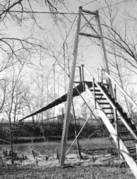
| Bridgemeister ID: | 140 (added before 2003) |
| Year Completed: | 1924 |
| Name: | Nocona |
| Also Known As: | Bluff, Ketchum Bluff, Ketchum's Bluff |
| Location: | Nocona vicinity, Texas and Jefferson County, Oklahoma, USA |
| Crossing: | Red River |
| At or Near Feature: | Ketchum Bluff |
| Coordinates: | 33.93579 N 97.75869 W |
| Maps: | Acme, GeoHack, Google, OpenStreetMap |
| Principals: | Austin Bridge Co. |
| References: | AUB, HAERTX98, PTS2 |
| Use: | Vehicular |
| Status: | Only towers remain (last checked: 2007) |
| Main Cables: | Wire (steel) |
| Main Span: | 1 x 213.4 meters (700 feet) |
Notes:
- Legend has it the bridge was burned during a dispute. This likely occurred before 1955. Some sources suggest it occurred before or during 1950. The road that leads to the Texas side of the former crossing is "Burned Out Bridge Road." Follow the image of the derelict tower to see the remains of the bridge.
- AUB mentions: "In January 1924, a contract was entered into with Nocona Bridge Company for a bridge across Red River, nine miles north of Nocona, connecting Texas and Oklahoma. The plans called for a 700' span, 16' roadway, and the main cables to contain 1,000 No. 9 galvanized wires each. The building of this, [the Austin Bridge Company's] first complete cable bridge, and the experience gained therefrom helped to launch Austin Bridge Company into an interesting and profitable line of work."
External Links:
- Nocona Suspension Bridge at Ketchum Bluff, Texas. University of Texas Arlington Libraries Digital Gallery
Image Sets:
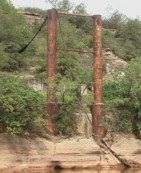
| Bridgemeister ID: | 1856 (added 2005-07-17) |
| Year Completed: | 1925 |
| Name: | (pipeline bridge) |
| Location: | Byers vicinity, Texas and Hastings, Oklahoma, USA |
| Crossing: | Red River |
| Coordinates: | 34.126861 N 98.213639 W |
| Maps: | Acme, GeoHack, Google, OpenStreetMap |
| Principals: | Austin Bridge Co. |
| References: | AUB |
| Use: | Pipeline |
| Status: | Removed |
| Main Cables: | Wire (steel) |
Notes:
- Coordinates provided here are the likely approximate location of the bridge. Two pipelines cross the Red River here. For many years they were elevated above the river. Piers are still (as of the 2020s) visible on the alignment indicated by the coordinates, and another set of piers slightly west.
- In AUB, two main spans and part of another suspended span are visible.
1926: Swinging
Pawhuska, Oklahoma, USA - Bird Creek
| Bridgemeister ID: | 3061 (added 2019-10-26) |
| Year Completed: | 1926 |
| Name: | Swinging |
| Location: | Pawhuska, Oklahoma, USA |
| Crossing: | Bird Creek |
| Coordinates: | 36.659110 N 96.341366 W |
| Maps: | Acme, GeoHack, Google, OpenStreetMap |
| Principals: | J.M. Buckley |
| Use: | Footbridge |
| Status: | In use (last checked: 2019) |
| Main Cables: | Wire (steel) |
Image Sets:
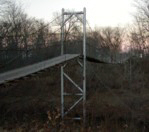
1927: Bryan-Fannin
Telephone, Bonham vicinity, Fannin County, Texas and Bryan County, Oklahoma, USA - Red River
| Bridgemeister ID: | 602 (added 2003-01-11) |
| Year Completed: | 1927 |
| Name: | Bryan-Fannin |
| Also Known As: | Telephone, Snow's Ferry, Bryant-Fannin |
| Location: | Telephone, Bonham vicinity, Fannin County, Texas and Bryan County, Oklahoma, USA |
| Crossing: | Red River |
| Coordinates: | 33.844484 N 96.011125 W |
| Maps: | Acme, GeoHack, Google, OpenStreetMap |
| Principals: | Austin Bridge Co. |
| References: | AUB, PTS2 |
| Use: | Vehicular |
| Status: | Collapsed, December, 1940 |
| Main Cables: | Wire (steel) |
| Suspended Spans: | 3 |
| Main Span: | 1 |
| Side Spans: | 2 |
Notes:
- Sometimes referenced as "Bryant-Fannin". The bridge unquestionably connected Fannin County to Bryan County, Oklahoma, but according to a www.rootsweb.com article (Fannin County TXGenWeb - Ferry's in Fannin County, from Pat Pryor, by Kathy J. Ellis) it was erected at a site known as "Bryant's Crossing" named for a local, Dave Bryant. The Steinman inventory lists it as "Bryan-Fannin". AUB mentions it as "Bryant-Fannin". The Rootsweb article also mentions it collapsed in 1940 under weight of a truck.
- An article in the December 6, 1940 issue of The Port Arthur News (Texas) titled: "Suspension Bridge Plunges Into Red River" describes the collapse: "Owners of a $75,000 tollbridge which plunged into the Red River Wednesday when a suspension cable anchor pulled loose were undecided today whether it would be rebuilt. The bridge, owned by the Austin Bridge company of Dallas, was near Telephone, Tex., 12 miles north of here, and was several miles from a principal highway. Most of the traffic from the Bonham area toward Oklahoma is across a structure built recently to replace a toll bridge at nearby Sowell's bluff that collapsed in 1930. Mrs. Jim Freeman, toll keeper, said she heard a 'rumble' and looked up to see the 'deadman anchor' pull loose, throwing the entire weight of the 1,300 foot span on the other cable. It snapped, and the flooring and steel framework of the bridge sagged into the water. No one was on the structure when it fell."
- Remains of three piers are still visible, 2019.
1927: Durant-Bonham
Bonham vicinity, Fannin County, Texas and Yuba/Durant vicinity, Oklahoma, USA - Red River
| Bridgemeister ID: | 603 (added 2003-01-11) |
| Year Completed: | 1927 |
| Name: | Durant-Bonham |
| Also Known As: | Sowell's Bluff |
| Location: | Bonham vicinity, Fannin County, Texas and Yuba/Durant vicinity, Oklahoma, USA |
| Crossing: | Red River |
| Principals: | Austin Bridge Co. |
| References: | AUB, PTS2 |
| Use: | Vehicular |
| Status: | Collapsed, 1934 |
| Main Cables: | Wire (steel) |
Notes:
- According to a rootsweb article (Fannin County TXGenWeb - Ferry's in Fannin County, from Pat Pryor, by Kathy J. Ellis), "when in 1932 this bridge fell, many people said that acid had been put on the cables to break them so that people from Oklahoma could not cross to Bonham." However, the true date of collapse may have been in 1934. The February 2, 1934 issue of The Daily Oklahoman has a front-page article with a photo of the bridge with collapsed deck. The photo is captioned: "The Red River Bridge on Highway 22 Near Durant After the Midnight Crash," and the article reads: "Here Is the debris of a $60,000 investment made by the states of Oklahoma and Texas eight months ago when they purchased the Bonham-Durant bridge across the Red river on highway 22. Three of the five spans of the 1,500-foot suspension bridge turned upside down and dropped into the river bed when a four-Inch wire cable rusted and broke in two about 15 feet from the ground on the Texas side. A lull in the usual heavy traffic across the bridge prevented accidents. The crash came at midnight, and one motorist had barely reached the Texas side when the cable gave away. Other motorists stopped their cars just in time to witness the spans of the bridge crash 40 feet into the stream. The bridge was built in 1926 and was operated as a toll bridge until 1933 when the two states bought it and made it a free crossing."
- In the October 1989 edition of the Oklahoma Water News an article (excerpted from an article in The Chronicles of Oklahoma by Dr. Bernice N. Crockett) states: "On January 15, 1934, a norther of terrific force came up which cause the Sowell's Bluff Bridge to fall. At 1 a.m. the wire cables on the Fannin side of the river became twisted, then snapped, broken in half, and the entire massive structure fell into the river below -- a complete wreck."
1927: Saint Jo
Illinois Bend, Saint Jo vicinity, Texas and Wilson vicinity, Oklahoma, USA - Red River
| Bridgemeister ID: | 601 (added 2003-01-11) |
| Year Completed: | 1927 |
| Name: | Saint Jo |
| Also Known As: | Airline, Air-Line |
| Location: | Illinois Bend, Saint Jo vicinity, Texas and Wilson vicinity, Oklahoma, USA |
| Crossing: | Red River |
| Coordinates: | 33.917051 N 97.486010 W |
| Maps: | Acme, GeoHack, Google, OpenStreetMap |
| Principals: | Austin Bridge Co. |
| References: | AUB, PTS2 |
| Use: | Vehicular (one-lane) |
| Status: | Removed |
| Main Cables: | Wire (steel) |
| Suspended Spans: | 1 |
| Main Span: | 1 x 213.4 meters (700 feet) |
External Links:
- St Jo "Airline" Suspension Bridge over the Red River Texas - Facebook. Coordinates provided here are based on the research presented in this Bridgehunting Texas Facebook group post.
| Bridgemeister ID: | 2378 (added 2007-10-21) |
| Year Completed: | 1929 |
| Name: | Idabel-Clarksville |
| Location: | Idabel vicinity, Oklahoma and Clarksville vicinity, Texas, USA |
| Crossing: | Red River |
| Principals: | Austin Bridge Co. |
| References: | AUB |
| Use: | Vehicular |
| Status: | Destroyed, 1933 |
| Main Cables: | Wire (steel) |
| Suspended Spans: | 3 |
| Main Span: | 1 x 213.4 meters (700 feet) |
| Side Spans: | 2 x 76.2 meters (250 feet) |
| Deck width: | 16 feet |
Notes:
- The November 1933 issue of The Wisconsin Engineer (a publication of the University of Wisconsin) has an article by C.W.P. Walter about research that was being performed by the University of Wisconsin's Engineering Department: "The particular hardware laden contrivance [in the Engineering Building] is a half-model of the Red River Bridge which carried light highway traffic between Clarksville, Texas, and Idabel, Oklahoma. In the early part of this year movement of the Red River as a result of flood waters washed away one of the intermediate piers supporting the end spans, and cause the cable to drop and be subjected to impact loading. It was contended by the company owning the bridge that the cable was overstressed and injured to such an extent that it would be necessary for the insurance company to replace the cable as well as the pier. A committee... was appointed to investigate the questions involved. While the investigation proceeded the Red River continued to scour away the foundation of the existing piers, ultimately causing the bridge to collapse completely."
- AUB mentions this bridge very briefly: "In 1928, [Jim Diamond] was employed by Austin Bridge Company as a consultant on the super-structure and cable work for the White River bridge at Des Arc. Later in the same year, he represented the owners as job engineer on the bridge built by the Company across Red River above Clarksville, Texas."
- Apparently this bridge was damaged by flood the same week it was supposed to open. In the October 1989 edition of the Oklahoma Water News an article (excerpted from an article in The Chronicles of Oklahoma by Dr. Bernice N. Crockett) writes: "The Austin Bridge Company completed the bridge May 19, 1929, but on May 23, when more than 400 people went to see the new bridge opened, an estimated 40 feet of the Red River bank had caved in near the bridge. Heavy rains continued to hinder road construction. A resident near the bridge recalled the night of May 19, 1929, as the night the river changed its course, and by morning had moved the entire structure into Oklahoma." The bridge eventually opened on June 20.
- The Friday December 30, 1932 edition of The Port Arthur News ran an article "Red River Bridge Damaged By Water". Texarkana, Dec. 30 (1932).: "High stages in Red River, that earlier this week demolished the Texas side approach to the privately owned suspension bridge [?] miles north of Clarksville on highway 37 to Idabel have been in recession since Wednesday but indicated continued heavy rains such as last night are expected to bring additional high water with probably further damage to the bridge. More than 50 feet of the approach is gone and the ground piers have crumpled, leaving the anchor cables alone holding the bridge in place."
- It appears the final end to this short-lived bridge didn't come until late May, 1933 when it was completely destroyed by flood.
External Links:
- Historic Suspension Bridges: Advent of the State Highway Department. This Texas Department of Transportation page mentions: "Five of the eleven suspension bridges built by [Austin Bridge Company] were toll bridges over the Red River. The Red River is notorious for its volatile, melting, red clay banks. The bridge between Clarksville, Texas, and Idabel, Oklahoma, was built by ABC in 1928, and washed out during flooding in 1932."
1949: (pipeline bridge)
Purcell vicinity, Oklahoma, USA - Canadian River
| Bridgemeister ID: | 1447 (added 2004-07-31) |
| Year Completed: | 1949 |
| Name: | (pipeline bridge) |
| Location: | Purcell vicinity, Oklahoma, USA |
| Crossing: | Canadian River |
| Principals: | Austin Bridge Co. |
| References: | AUB |
| Use: | Pipeline |
| Main Cables: | Wire (steel) |
Notes:
- Unusual for a pipeline suspension bridge, this bridge has at least two main spans.
1976: Kiwanis Club Bicentennial
Sulphur, Oklahoma, USA - Rock Creek
| Bridgemeister ID: | 5588 (added 2020-12-22) |
| Year Completed: | 1976 |
| Name: | Kiwanis Club Bicentennial |
| Location: | Sulphur, Oklahoma, USA |
| Crossing: | Rock Creek |
| Coordinates: | 34.508043 N 96.974723 W |
| Maps: | Acme, GeoHack, Google, OpenStreetMap |
| Use: | Footbridge |
| Status: | Removed |
Notes:
- The November 28, 1976 edition of The Ada Sunday News ran an article titled "Sulphur Foot Bridge Dedication Scheduled": "SULPHUR — The Kiwanis Club Bicentennial Bridge, a swinging foot bridge across Rock Creek, will be dedicated at 12:30 p.m. Tuesday... The suspension bridge, which was built across Rock Creek near the south end of Bulldog Stadium, has been open since late October. It provides easy access to the school grounds for students coming from east Sulphur. Designed by Supt. Calvin Agee and elementary Principal DeLannom, the bridge was built as the bicentennial project of the Sulphur Kiwanis Club. Club members and students from Sulphur's vocational training classes performed the work on the structure…"
- The Ada Sunday Newsarticle description leads one to believe this was not a very substantial structure and no trace of it appears to remain (in 2020). Coordinates provided here are, approximate, based on the location description in the article.
1992: (pipeline bridge)
Watson, Oklahoma, USA - Mountain Fork River
| Bridgemeister ID: | 1514 (added 2004-10-10) |
| Year Completed: | 1992 |
| Name: | (pipeline bridge) |
| Location: | Watson, Oklahoma, USA |
| Crossing: | Mountain Fork River |
| Coordinates: | 34.461641 N 94.554642 W |
| Maps: | Acme, GeoHack, Google, OpenStreetMap |
| Principals: | Clear Span Engineering, Inc. |
| Use: | Pipeline |
| Status: | Extant (last checked: 2019) |
| Main Cables: | Wire (steel) |
| Main Span: | 1 x 236.2 meters (775 feet) |
Notes:
- Carries a 48-inch gas pipeline.
2017: Inkana
Sulphur, Oklahoma, USA - Rock Creek
| Bridgemeister ID: | 3044 (added 2019-10-19) |
| Year Completed: | 2017 |
| Name: | Inkana |
| Location: | Sulphur, Oklahoma, USA |
| Crossing: | Rock Creek |
| At or Near Feature: | Chickasaw Cultural Center |
| Coordinates: | 34.491860 N 96.992191 W |
| Maps: | Acme, GeoHack, Google, OpenStreetMap |
| Use: | Footbridge |
| Status: | In use (last checked: 2019) |
| Main Cables: | Wire (steel) |
| Bridgemeister ID: | 1125 (added 2004-01-11) |
| Name: | (footbridge) |
| Location: | Broken Arrow, Oklahoma, USA |
| At or Near Feature: | Ray Harral Nature Park |
| Coordinates: | 35.98443 N 95.78731 W |
| Maps: | Acme, GeoHack, Google, OpenStreetMap |
| Use: | Footbridge |
| Status: | In use (last checked: 2006) |
| Main Cables: | Wire (steel) |
| Suspended Spans: | 1 |
Image Sets:
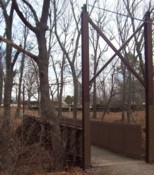
(footbridge)
Mountain Park, Oklahoma, USA - East Otter Creek
| Bridgemeister ID: | 1059 (added 2003-12-13) |
| Name: | (footbridge) |
| Location: | Mountain Park, Oklahoma, USA |
| Crossing: | East Otter Creek |
| Coordinates: | 34.691902 N 98.949943 W |
| Maps: | Acme, GeoHack, Google, OpenStreetMap |
| Use: | Footbridge |
| Status: | Extant (last checked: 2019) |
| Main Cables: | Wire (steel) |
| Suspended Spans: | 1 |
| Bridgemeister ID: | 812 (added 2003-05-29) |
| Name: | (footbridge) |
| Location: | Norman, Oklahoma, USA |
| Crossing: | Duck Pond |
| At or Near Feature: | University of Oklahoma |
| Coordinates: | 35.207327 N 97.436762 W |
| Maps: | Acme, GeoHack, Google, OpenStreetMap |
| Use: | Footbridge |
| Status: | In use (last checked: 2018) |
| Suspended Spans: | 1 |
Notes:
- Tiny footbridge. Main span likely less than 30 feet.
(footbridge)
Wagoner County, Oklahoma, USA - Verdigris River
| Bridgemeister ID: | 2683 (added 2019-05-26) |
| Name: | (footbridge) |
| Location: | Wagoner County, Oklahoma, USA |
| Crossing: | Verdigris River |
| Coordinates: | 35.902837 N 95.473832 W |
| Maps: | Acme, GeoHack, Google, OpenStreetMap |
| Use: | Footbridge |
| Status: | Extant (last checked: 2015) |
| Main Cables: | Wire |
Notes:
- One of two nearby likely derelict suspension bridges across arms of the Verdigris. May be a third nearby suspension bridge across the arm of the Verdigris into which Strawberry Creek flows.
- Near (footbridge) - Wagoner County, Oklahoma, USA.
External Links:
(footbridge)
Wagoner County, Oklahoma, USA - Verdigris River
| Bridgemeister ID: | 2684 (added 2019-05-26) |
| Name: | (footbridge) |
| Location: | Wagoner County, Oklahoma, USA |
| Crossing: | Verdigris River |
| Coordinates: | 35.903865 N 95.477601 W |
| Maps: | Acme, GeoHack, Google, OpenStreetMap |
| Use: | Footbridge |
| Status: | Extant (last checked: 2015) |
| Main Cables: | Wire |
Notes:
- One of two nearby likely derelict suspension bridges across arms of the Verdigris. May be a third nearby suspension bridge across the arm of the Verdigris into which Strawberry Creek flows.
- Near (footbridge) - Wagoner County, Oklahoma, USA.
External Links:
(pipeline bridge)
Hominy, Oklahoma, USA - Hominy Creek
| Bridgemeister ID: | 3621 (added 2019-12-31) |
| Name: | (pipeline bridge) |
| Location: | Hominy, Oklahoma, USA |
| Crossing: | Hominy Creek |
| Coordinates: | 36.473875 N 96.378850 W |
| Maps: | Acme, GeoHack, Google, OpenStreetMap |
| Use: | Pipeline |
| Status: | Extant (last checked: 2019) |
| Main Cables: | Wire (steel) |
| Suspended Spans: | 1 |
| Bridgemeister ID: | 279 (added before 2003) |
| Name: | (suspension bridge) |
| Location: | Gainesville vicinity, Texas and Love County, Oklahoma, USA |
| Crossing: | Red River |
| Coordinates: | 33.718156 N 97.129504 W |
| Maps: | Acme, GeoHack, Google, OpenStreetMap |
| Use: | Vehicular |
| Status: | Removed |
| Main Cables: | Wire |
External Links:
- Lost Red River Suspension Bridges - Gainesville Texas. Coordinates provided here are based on the research presented in this Bridgehunting Texas Facebook group post.
Ripley
Ripley, Oklahoma, USA - Cimarron River
| Bridgemeister ID: | 5586 (added 2020-12-22) |
| Name: | Ripley |
| Location: | Ripley, Oklahoma, USA |
| Crossing: | Cimarron River |
| Coordinates: | 36.028302 N 96.905843 W |
| Maps: | Acme, GeoHack, Google, OpenStreetMap |
| Use: | Vehicular |
| Status: | Only towers remain (last checked: 2020) |
| Main Cables: | Wire (steel) |
| Main Span: | 1 |
Notes:
- Pier and abutment remnants of this bridge are still present (2020).
- Replaced 1909 Ripley - Ripley, Oklahoma, USA.
- All past and present bridges at this location.
Image Sets:
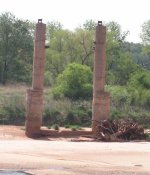
Swinging
Kingfisher, Oklahoma, USA - Uncle John's Creek
| Bridgemeister ID: | 309 (added before 2003) |
| Name: | Swinging |
| Location: | Kingfisher, Oklahoma, USA |
| Crossing: | Uncle John's Creek |
| Coordinates: | 35.859049 N 97.927810 W |
| Maps: | Acme, GeoHack, Google, OpenStreetMap |
| Use: | Footbridge |
| Status: | In use (last checked: 2016) |
| Main Cables: | Wire |
| Suspended Spans: | 1 |
Image Sets:
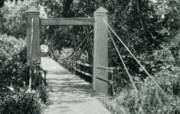
Swinging
Medicine Park, Oklahoma, USA - Medicine Creek
| Bridgemeister ID: | 311 (added before 2003) |
| Name: | Swinging |
| Location: | Medicine Park, Oklahoma, USA |
| Crossing: | Medicine Creek |
| Coordinates: | 34.728561 N 98.502889 W |
| Maps: | Acme, GeoHack, Google, OpenStreetMap |
| Use: | Footbridge |
| Status: | Only towers remain |
| Main Cables: | Wire |
| Suspended Spans: | 1 |
Notes:
- Now known as the Curtis Davis Bridge, the suspended span appears to have been replaced with a truss and non-functional suspension cables. The original suspension bridge towers remain.
Swinging
Nowata, Oklahoma, USA - Verdigris River
| Bridgemeister ID: | 1310 (added 2004-04-10) |
| Name: | Swinging |
| Location: | Nowata, Oklahoma, USA |
| Crossing: | Verdigris River |
| Use: | Vehicular |
| Status: | Removed |
| Main Cables: | Wire |
| Main Span: | 1 |
Image Sets:
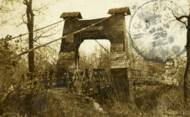

Do you have any information or photos for these bridges that you would like to share? Please email david.denenberg@bridgemeister.com.
Mail | Facebook | X (Twitter) | Bluesky
